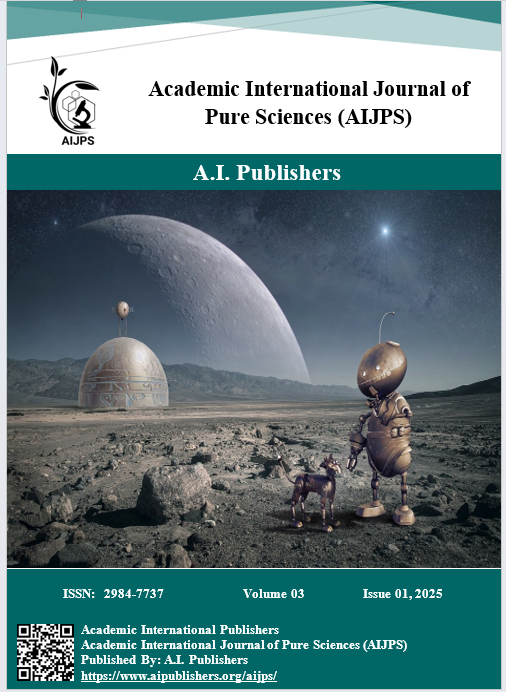Physiological Blood Changes Among Smokers and Their Effects
DOI:
https://doi.org/10.59675/P211Keywords:
RBC, HB, PCV, MCH, MCHC, Erythrocyte, HT, TCTAbstract
Background: Cigarette aids foster this type of art of evolution. involves the emergence and development of a number of long-term or age-associated diseases Heart attacks or pulmonary cancer are the most common causes of death throughout America, and they continue to be amongst the top illnesses and reasons of death among cigarettes. anomalies in the blood vessels These have been related to damage from oxidation and tissue-level cardiac collapse. A substantial relationship is present among increased levels of packed-cell hemoglobin and development. Aim: Goals Examining the deleterious effects of tobacco on blood vessel red blood cell count, the amount of hemoglobin, and consequent indices of red blood cell count is essential when attempting to create initiatives to discourage smoking or increase the public's understanding. Such results ought to be taken into account contrasted to those from other countries. Method: An investigation was carried out using a cross-sectional descriptive research design that investigated relationship between hemoglobin levels and the number of blood cells counts, specifically white blood cell counts, in relation to a typical age spectrum of 20–50 years. Out of the 100 guys that participated in the experiment, –50 weren't using cigarettes and –50 did. Result: The present investigation looked at the protein hemoglobin red cell characteristics, HCT (the PCV), that matched with mature smokes' erythrocyte measure. PCV targets, MCH levels, and peptide hemoglobin number of cells are significantly (p>0.05) elevated in a specific set of males that smokers to diverse degrees. potentially raise one's blood levels of HB, PCV, RBC, MCV, MCH, and MHC relative to those who do not smoke; nevertheless, no discernible change was observed. Conclonsion : The present research used hemoglobin, erythrocyte measure, and screening for maturation in smokers. It is found that smoke increases levels of hemoglobin, red cell indices, and the B-complex to people, resulting in a persistent hypoxia condition.
References
Shah RS, Cole JW. Smoking and stroke: the more you smoke the more you stroke. Expert Rev Cardiovasc Ther. 2010;8(7):917-32.
Law MR, Morris JK, Wald NJ. Environmental tobacco smoke exposure and ischaemic heart disease: an evaluation of the evidence. BMJ. 1997;315(7114):973-80.
Lu JT, Creager MA. The relationship of cigarette smoking to peripheral arterial disease. Rev Cardiovasc Med. 2004;5(4):189-93.
Messner B, Bernhard D. Smoking and cardiovascular disease: mechanisms of endothelial dysfunction and early atherogenesis. Arterioscler Thromb Vasc Biol. 2014;34(3):509-15.
Glantz SA, Bareham DW. E-cigarettes: use, effects on smoking, risks, and policy implications. Annu Rev Public Health. 2018;39:215-35.
Abrams DB, Glasser AM, Pearson JL, Villanti AC, Collins LK, Niaura RS. Harm minimization and tobacco control: reframing societal views of nicotine use to rapidly save lives. Annu Rev Public Health. 2018;39:193-213.
Frazer K, Kelleher C. Reducing tobacco smoke exposure for vulnerable groups: hospital settings and teachable moments. Perspect Public Health. 2018;138(3):142-4.
Anandha Lakshmi S, Anandhi Lakshmanan GKP, Saravanan A. Effect of intensity of cigarette smoking on haematological and lipid parameters. J Clin Diagn Res. 2014;8(7)
.Whitehead TP, Robinson D, Allaway SL, Hale AC. The effects of cigarette smoking and alcohol consumption on blood haemoglobin, erythrocytes and leucocytes: a dose related study on male subjects. Clin Lab Haematol. 1995;17(2):131-8.
Aitchison R, Russell N. Smoking-a major cause of polycythaemia. J R Soc Med. 1988;81(2):89-91.
Verma RJ, Patel CS. Effect of smoking on Haematological parameters in Human Beings. J Cell Tissue Res. 2015;5(1):337.
Kung CM, Wang HL, Tseng ZL. Cigarette smoking exacerbates health problems in young men. Clin Investig Med. 2008;E138-E149.
Malenica M, Prnjavorac B, Bego T, Dujic T, Semiz S, Skrbo S, Causevic A, et al. Effect of cigarette smoking on haematological parameters in healthy population. Med Arch. 2017;71(2):132.
Shah BK, Nepal AK, Agrawal M, Sinha AK. The effects of cigarette smoking on hemoglobin levels compared between smokers and non-smokers. Sunsari Tech Coll J. 2012;1(1):42-44.
Asif M, Karim S, Umar Z, Malik A, Ismail T, Chaudhary A, Rasool M, et al. Effect of cigarette smoking based on hematological parameters: comparison between male smokers and non-smokers. Turk J Biochem. 2013;38(1).
Nadia MM, Shamseldein HA, Sara AS. Effects of Cigarette and Shisha Smoking on Hematological Parameters: An analytic case-control study. Int Multispecialty J Health. 2015;1(10):44–51.
Anandha Lakshmi S, Anandhi Lakshmanan GKP, Saravanan A. Effect of intensity of cigarette smoking on haematological and lipid parameters. J Clin Diagn Res. 2014;8(7)
Whitehead TP, Robinson D, Allaway SL, Hale AC. The effects of cigarette smoking and alcohol consumption on blood haemoglobin, erythrocytes and leucocytes: a dose related study on male subjects. Clin Lab Haematol. 1995;17(2):131-138.
Khan MI, Bukhari MH, Akhtar MS, Brar S. Effect of smoking on Red Blood Cells Count, Hemoglobin Concentration and Red Cell indices. P J M H S. 2014;8(2):361–4.






